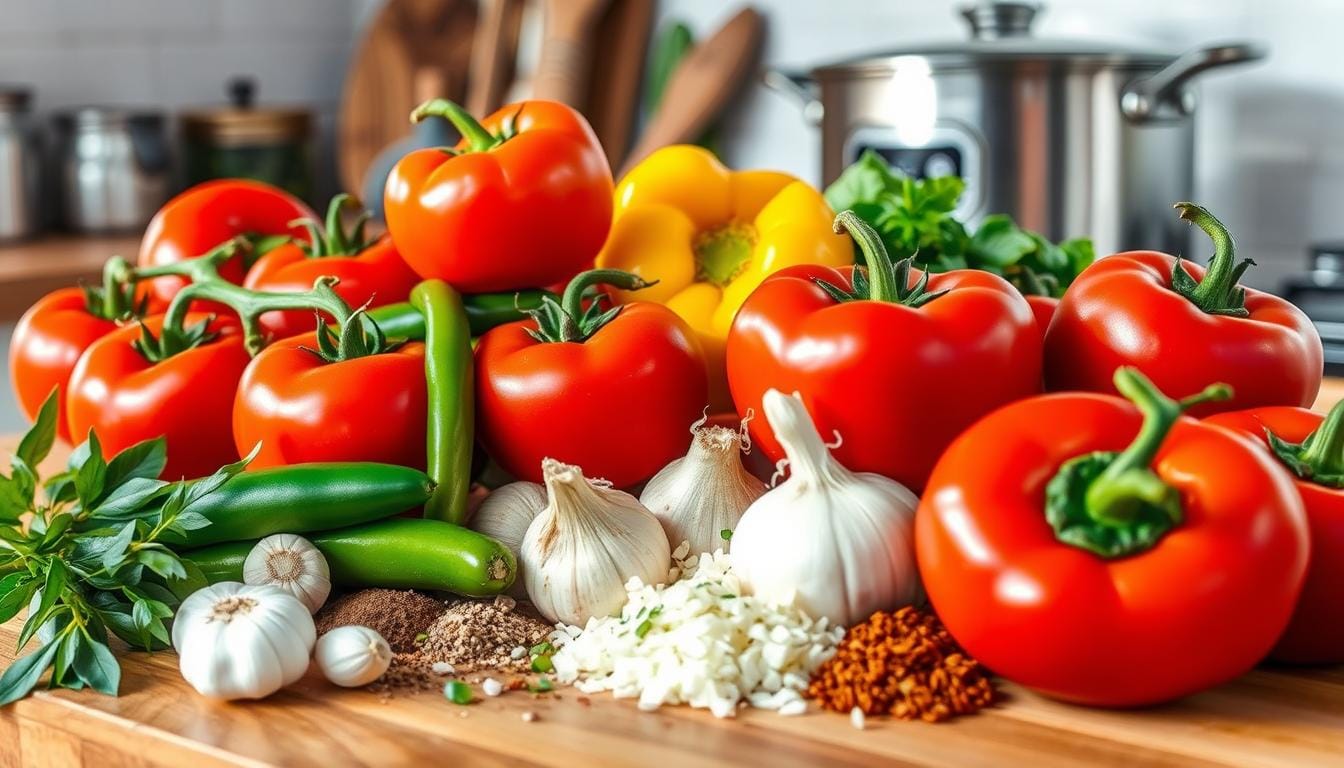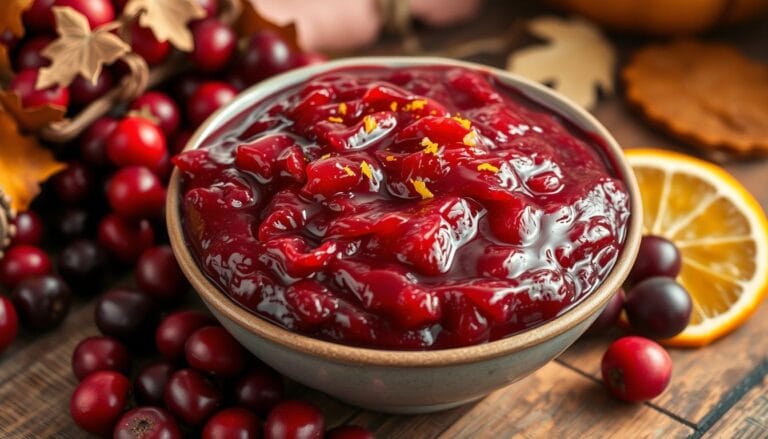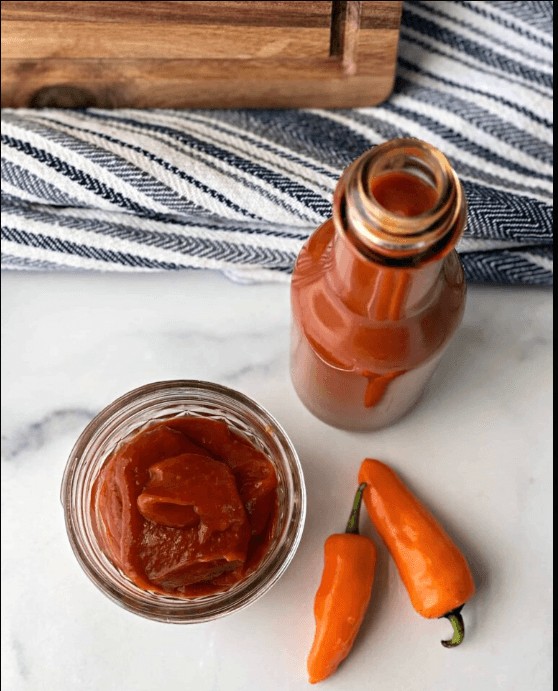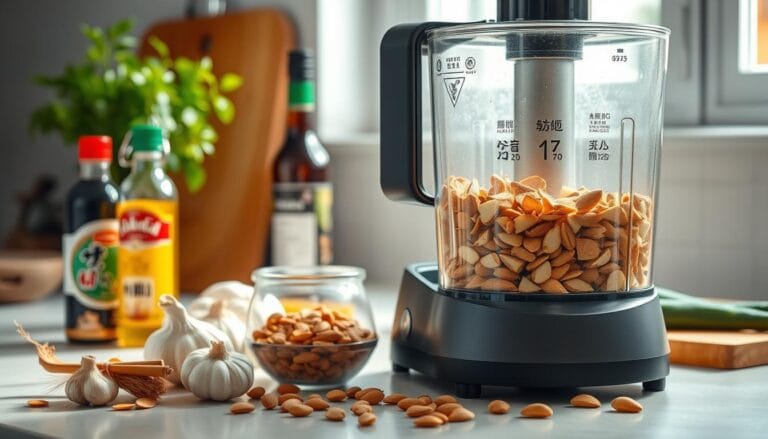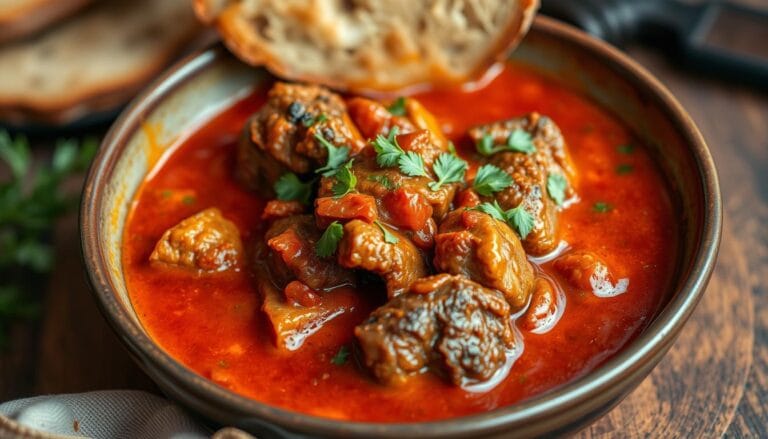sauce piquante recipe
Growing up in Cajun country, the smell of Sauce Piquante filled my grandmother’s kitchen. It was a mix of spices and simmered meat. This spicy stew was more than food; it was a family tradition and a piece of South Louisiana’s culture.
Table of Contents
Understanding Sauce Piquante’s Cultural Heritage
Sauce Piquante is a favorite in Louisiana, rooted in Cajun and Creole cuisines. It shows how different cultures blend to create a unique taste. French, West African, Italian, Spanish, and Caribbean flavors come together in this stew.
Origins in Cajun and Creole Cuisine
The story of Sauce Piquante starts with the Cajun and Creole communities in Louisiana. These cuisines have grown over time, using local ingredients and slow cooking. They make dishes that are both warm and complex.
The French Influence on Sauce Piquante
The French touch is clear in Sauce Piquante’s roux base. This method, cooking flour and fat slowly, is key in Cajun and Creole cooking. It’s seen in many classic dishes, including Sauce Piquante.
Cultural Significance in Louisiana
Sauce Piquante is more than food; it’s a piece of Louisiana’s cultural story. It shows the region’s cooking traditions and the creativity of its people. With its mix of spices and meats, it captures Louisiana’s unique taste.
| Statistic | Fact |
|---|---|
| Storage Life | Picante sauce can be stored in the refrigerator for up to three days, or frozen for up to 3 months. |
| Spice Adjustability | Picante sauce can be made spicier by leaving jalapeno seeds in or by adding additional hot sauce. |
| Tomato Substitution | Fresh tomatoes can be used in place of canned tomatoes to make picante sauce. |
| Texture Comparison | Picante sauce is smoother in texture compared to chunky salsa. |
“The depth of flavor in Sauce Piquant recipes is achieved through a layering of various peppers.”
Essential Ingredients for Sauce Piquante Recipe
Making the perfect spicy sauce ingredients for a delicious homemade hot sauce or piquant sauce is key. Every part, from the protein to the veggies, is crucial. They help create the unique flavors of this Cajun and Creole dish.
The heart of Sauce Piquante is the protein, like chicken, turtle, or rabbit. These are browned in oil or butter, adding flavor. Onions, bell peppers, and celery form the aromatic base. Garlic adds a strong taste.
- Variety of peppers: black, white, jalapeños, cayenne, red pepper flakes
- Tomatoes: whole, diced, or tomato paste
- Wine (dry white or red, depending on the protein)
- Stock (matching the protein used)
- Worcestershire sauce and Creole seasoning for seasoning
Using the best ingredients, you get the spicy sauce ingredients and flavors that make homemade hot sauce and piquant sauce special.
“The key to a truly remarkable Sauce Piquante is the careful selection and balance of its essential ingredients. Each element contributes to the overall depth of flavor, creating a dish that is both comforting and captivating.”
The Holy Trinity: Foundation of Flavor
The “holy trinity” is at the heart of Cajun and Creole cooking. It’s a mix of yellow onions, bell peppers, and celery. Together, they create the rich flavors found in dishes like Sauce Piquante.
Proper Vegetable Preparation
Getting the holy trinity right is crucial. Instead of chopping finely, go for a rougher texture. This lets each flavor stand out and adds a hearty feel to the dish.
Importance of Fresh Ingredients
Using fresh ingredients is key for a true cajun or creole sauce. The holy trinity is the base, so choose the freshest onions, peppers, and celery. This keeps the flavors bright and the texture crisp.
Seasoning Combinations
Seasonings like parsley, paprika, and cayenne pepper add to the flavor of Sauce Piquante. These spices blend with the holy trinity, making the dish’s taste complex and rich. This is what makes Cajun and Creole cuisine special.
“The holy trinity is the foundation of Cajun and Creole cuisine – the base upon which all other flavors are built.”
Mastering the Perfect Roux
The cajun sauce recipe starts with a key ingredient: the roux. It’s a mix of flour and fat that adds depth and richness to the homemade hot sauce. Learning to make a great roux is a skill that sets apart the newbies from the seasoned cooks.
The roux for sauce piquante should be dark brown, like milk chocolate. This color, called the “Medium Brown Roux,” brings out the best flavors and texture. Making this roux takes patience and focus, as it can quickly turn from perfect to burnt.
- Begin by heating your fat, like oil or butter, in a heavy pan over medium heat.
- Slowly add an equal amount of flour, mixing well.
- Keep stirring for 8-10 minutes until it’s a rich, chocolate-like color.
- Watch closely, as the roux can burn fast. Adjust the heat to keep it cooking slowly.
If you need a gluten-free option, try a “Trinity Roux™” made with tapioca flour. It works just as well and is safe for those with gluten allergies.
“The roux is the heart and soul of Cajun and Creole cuisine. It’s the foundation that gives these dishes their signature depth of flavor.”
Remember, the roux is what makes sauce piquante special. With practice, you’ll get better at making the perfect roux. This will take your cajun sauce recipe to the next level.
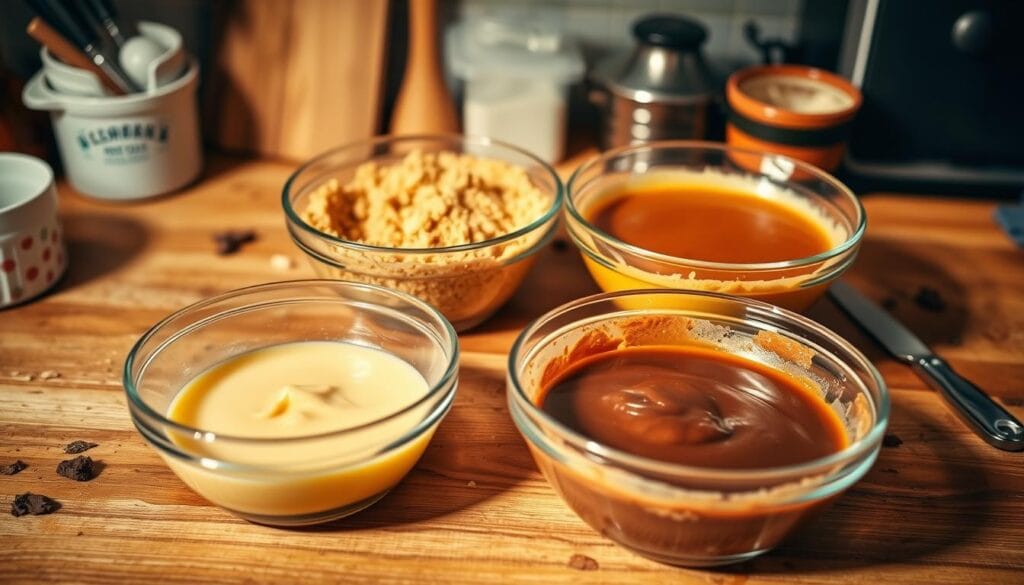
Choosing and Preparing Your Protein
When making the perfect sauce piquante recipe, picking and preparing your protein is key. You can use chicken, turtle, rabbit, alligator, or seafood. Chicken is a favorite, often cut into 10 pieces to cook evenly.
For tougher meats, the cajun sauce recipe‘s long cooking time tenderizes them. Before adding the meat, marinate it in broth, Worcestershire sauce, and spices. This boosts flavor and tenderness.
Traditional Meat Options
- Chicken (whole bird, cut into 10 pieces, with breasts halved)
- Turtle
- Rabbit
- Alligator
- Seafood (shrimp, crawfish, catfish, etc.)
Marination Techniques
- Mix together broth, Worcestershire sauce, and spices
- Marinate the protein for at least 30 minutes, or up to 24 hours
- The longer the marination, the more flavorful and tender the protein will be
Proper Cutting and Sizing
It’s important to cut the meat into stew-sized pieces, about 1-2 inches. This ensures even cooking and helps the meat blend well with the sauce piquante recipe. Also, browning the meat before adding it to the sauce adds more flavor.
| Ingredient | Quantity | Nutrition Facts |
|---|---|---|
| Chicken | 8 pieces (whole bird, cut into 10 pieces, with breasts halved) | Calories: 25, Fat: 0g, Carbs: 6g, Protein: 1g, Sodium: 72mg, Vitamin C: 20.7mg, Calcium: 19.6mg, Iron: 0.5mg, Potassium: 211.1mg |
| Turtle | 1 lb, cubed | Calories: 25, Fat: 0g, Carbs: 6g, Protein: 1g, Sodium: 72mg, Vitamin C: 20.7mg, Calcium: 19.6mg, Iron: 0.5mg, Potassium: 211.1mg |
| Rabbit | 1 lb, cubed | Calories: 25, Fat: 0g, Carbs: 6g, Protein: 1g, Sodium: 72mg, Vitamin C: 20.7mg, Calcium: 19.6mg, Iron: 0.5mg, Potassium: 211.1mg |
| Alligator | 1 lb, cubed | Calories: 25, Fat: 0g, Carbs: 6g, Protein: 1g, Sodium: 72mg, Vitamin C: 20.7mg, Calcium: 19.6mg, Iron: 0.5mg, Potassium: 211.1mg |
Step-by-Step Sauce Piquante Recipe
Making the perfect sauce piquante recipe is a journey worth taking. It’s a spicy, flavorful dish from Louisiana, blending Cajun and Creole flavors. With a few steps, you can make this homemade hot sauce in your kitchen. Let’s explore how to make an authentic louisiana hot sauce.
- Start by marinating and browning your protein, like chicken, shrimp, or rabbit.
- Then, make a dark roux, the base of a great sauce piquante.
- With the roux, sauté onions, bell peppers, celery, and garlic.
- Add spices like cayenne, paprika, and thyme to deepen the flavor.
- Use tomato products like paste, sauce, and diced tomatoes for the spicy base.
- Use white wine and stock to deglaze the pot, then add the browned protein.
- Simmer the sauce for hours, stirring and skimming fat, until it’s rich and meat is tender.
- Finally, add mushrooms for extra texture and umami.
- Season to taste, aiming for a balance of heat, acidity, and richness.
Creating sauce piquante requires patience and care. The long simmering time lets the flavors blend, making a top-notch louisiana hot sauce. Serve it over rice for a taste of Louisiana’s rich heritage.
| Ingredient | Amount |
|---|---|
| Rabbit (or other protein) | 2 rabbits (yielding about 3 cups shredded meat) |
| Yellow Onions | 2 large |
| Garlic Cloves | 5 |
| Green Bell Peppers | 2 |
| Celery Stalks | 3 |
| Jalapeños | 3 |
| Dry White Wine | 1 cup |
| Hard-Cooked Eggs | 12 |
| Cocktail Onions | 1 cup |
| Pitted Black Olives | 1 cup |
| Sliced Green Onion | 1 cup |
| Lemons | 4 |
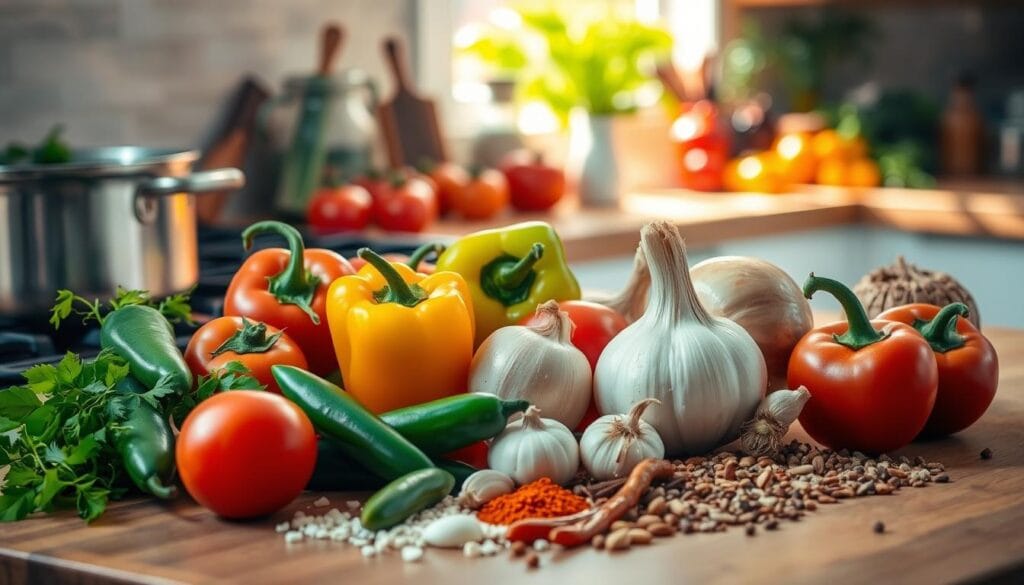
Creating the Signature Spicy Tomato Base
The tomato base is the heart of Sauce Piquante. It’s made from a mix of tomato products like whole or diced tomatoes, tomato paste, and sometimes Rotel tomatoes. Crushing whole tomatoes by hand adds a rustic touch. Tomato paste brings depth and richness.
Tomato Selection Tips
Choose high-quality, ripe tomatoes for the best flavor. Pick them during peak season for the best taste. Use whole or diced canned tomatoes for the best results.
Balancing Heat Levels
You can adjust the heat in Sauce Piquante to your liking. Use fresh peppers like jalapeños and dried spices like cayenne pepper and red pepper flakes. The goal is to balance the spiciness with other flavors.
For more heat, add more of your favorite peppers. But remember, the piquant sauce should be enjoyable for everyone.
| Ingredient | Quantity | Scoville Heat Units |
|---|---|---|
| Jalapeño Peppers | 2-3 | 2,500 – 8,000 |
| Cayenne Pepper | 1 tsp | 30,000 – 50,000 |
| Red Pepper Flakes | 1/2 tsp | 2,500 – 5,000 |
By choosing and balancing the right spicy sauce ingredients, you can make a piquant sauce. It will excite your taste buds and bring the true flavors of Cajun and Creole cuisine.
Wine and Stock Selection Guide
Choosing the right wine and stock is crucial for your sauce piquante or cajun sauce recipe. For chicken or seafood, a dry white wine is best. Red wine is better for turtle or rabbit dishes.
It’s smart to match the stock with the protein. Chicken stock is great for chicken-based sauce piquante. Seafood stock is best for seafood dishes. But, chicken stock can work for most recipes. Wine and stock add depth and tenderize the meat during cooking.
| Protein | Recommended Wine | Recommended Stock |
|---|---|---|
| Chicken or Seafood | Dry white wine | Chicken or seafood stock |
| Turtle or Rabbit | Red wine | Chicken or beef stock |
Choosing wine and stock that match your main ingredient is key. This ensures a balanced and tasty dish. It brings out the best of Cajun and Creole flavors.
Traditional Serving Suggestions and Pairings
Serving Louisiana hot sauce, also known as Sauce Piquante, has a few classic ways. The most common is over fluffy white rice, which soaks up the sauce’s flavor. For a low-carb option, try cauliflower rice. Fresh French bread is also served to clean up any leftover sauce.
Adding garnishes like green onions can enhance Sauce Piquante. Their bright color and fresh taste contrast well with the sauce’s richness. Some recipes also include potato salad or corn maque choux as sides.
For drinks, light beers or dry white wines work well with Sauce Piquante. Their acidity and bubbles balance the sauce’s heat and richness. These pairings help bring out the best in Louisiana hot sauce.
